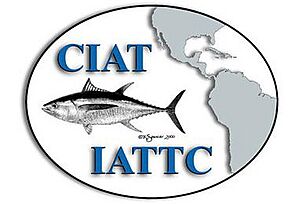Inter-American Tropical Tuna Commission facts for kids

Logo of the Inter-American Tropical Tuna Commission
|
|
| Abbreviation | IATTC / Spanish: Comisión Interamericana del Atún Tropical (CIAT) |
|---|---|
| Formation | 1949 |
| Type | tuna regional fishery management organisation |
| Legal status | International organization |
| Purpose | Fisheries management |
| Headquarters | La Jolla, San Diego, United States |
|
Area served
|
Eastern Pacific Ocean |
|
Membership
|
21 members |
|
Director
|
Arnulfo Franco |
The Inter-American Tropical Tuna Commission (IATTC) is an important group that works to protect tuna and other sea creatures in the eastern Pacific Ocean. Think of it as a special team that makes sure fishing for tuna is done in a smart way. This helps make sure there are always enough fish for the future. They also help protect dolphins that live in the same ocean areas.
Contents
How the IATTC Started
The IATTC was created a long time ago, on May 31, 1949. The United States and Costa Rica were the first countries to sign an agreement to start it. Their goal was to work together to manage tuna fishing. Over time, many more countries joined this important commission. Each country can have up to four people representing them.
In 2003, the countries that were part of the IATTC signed a new agreement. It was called the Antigua Convention. This agreement made the IATTC even stronger. It gave it more power to protect ocean life. The main office of the IATTC is in La Jolla, San Diego, California, in the United States.
Countries Working with the IATTC
Many countries are members of the IATTC. They all work together to protect tuna and other marine life. Some countries have officially agreed to the original Convention.
Here are the members:
- Belize
- Canada* (left the Convention in 1983)
- China
- Colombia*
- Costa Rica*
- Ecuador*
- El Salvador*
- European Union
- France*
- Guatemala*
- Japan*
- Kiribati
- South Korea*
- Mexico*
- Nicaragua*
- Panama*
- Peru*
- Chinese Taipei
- United States*
- Vanuatu*
- Venezuela*
The IATTC also works with other countries that are not full members. These are called "Cooperating Non-Members." They still help with the IATTC's goals.
Cooperating Non-Members
Protecting Dolphins
The IATTC has a very important job in protecting dolphins. They run a program called the International Dolphin Conservation Program (IDCP). The main goal of this program is to reduce the number of dolphins that accidentally get caught in tuna fishing nets. They want to get this number as close to zero as possible.
This program has been very successful! In 2013, almost all (95.4%) of the times that fishing boats caught tuna near dolphins, no dolphins were harmed. The total number of dolphins accidentally caught has dropped a lot. It went from about 132,000 in 1986 to only about 800 in 2013. This shows how well the program has worked.
Researching Tropical Tunas
The IATTC also does a lot of scientific research. They have a special place called the Achotines Laboratory. This lab is one of the few places in the world that studies the early life of tropical tunas. This includes their eggs, baby fish (larvae), and young fish.
Tunas are open-ocean fish, which means they live far out in the sea. This makes them very hard to study in their natural home. Scientists don't know much about how tunas reproduce or what their very early life stages are like. The Achotines Laboratory helps scientists learn more about these important parts of tuna biology. While tunas are the main focus, the lab can also support other ocean and land science research.
See also

